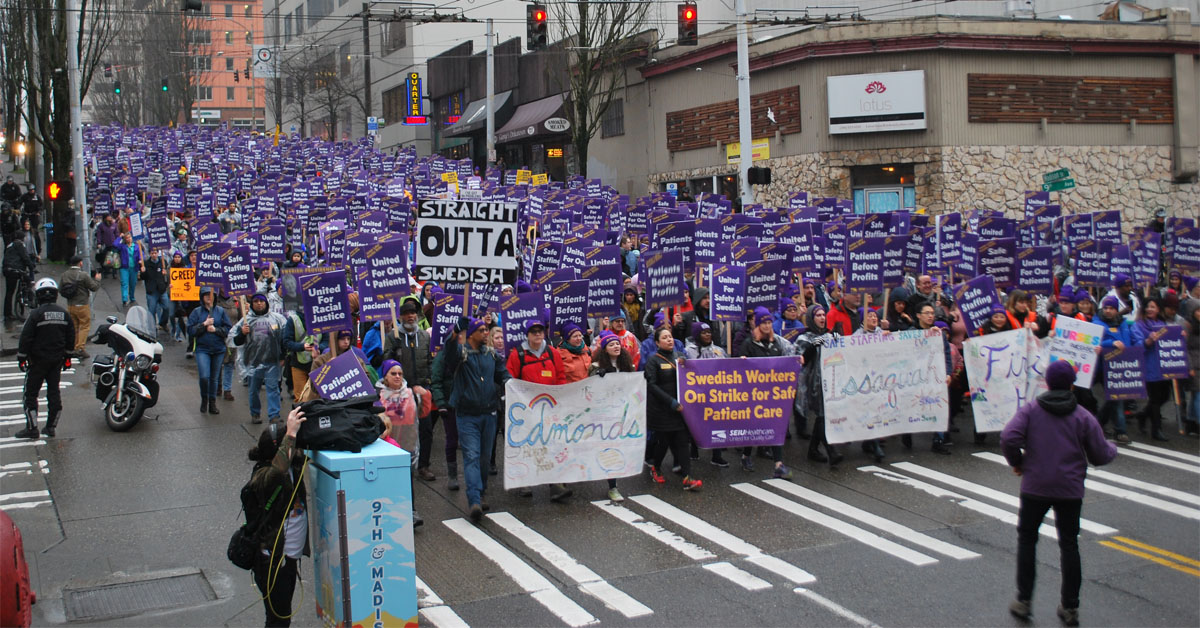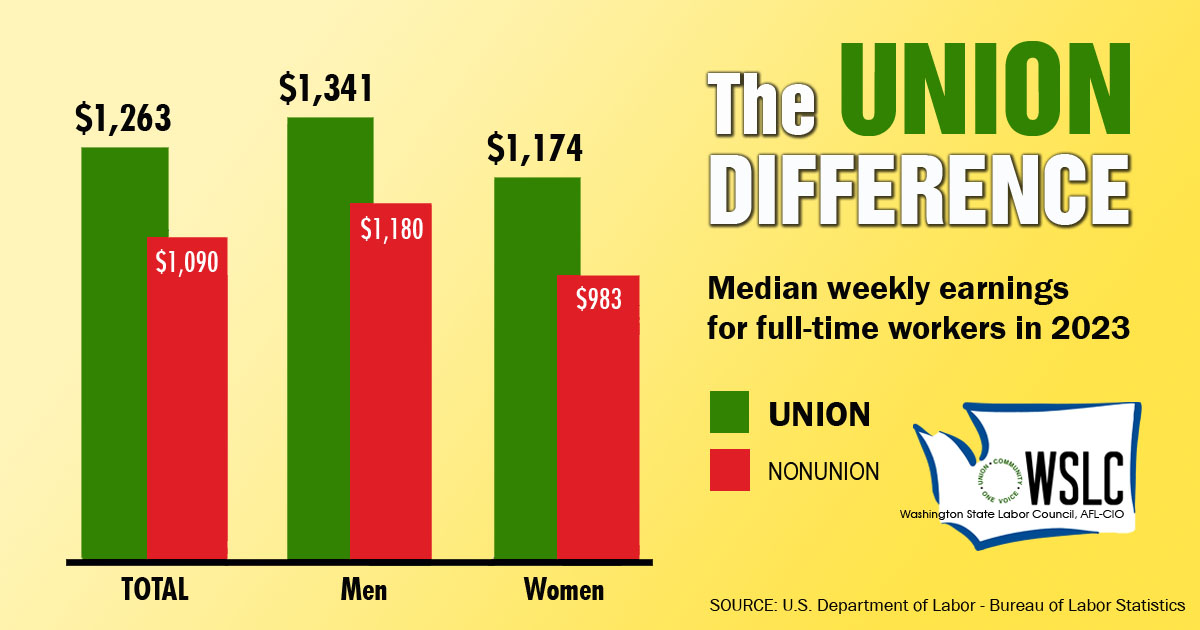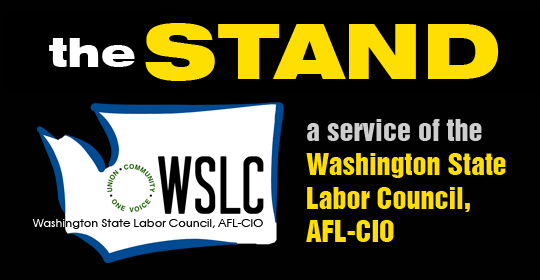NATIONAL
Get the facts: Unions help reduce disparities, strengthen democracy
The following fact sheet (available as a printable PDF) is from the Economic Policy Institute:
WASHINGTON, D.C. (May 13, 2021) — Unions improve wages and benefits for all workers, not just union members. They help reduce income inequality by making sure all Americans, and not just the wealthy elite, share in the benefits of their labor.
Unions also reduce racial disparities in wages and raise women’s wages, helping to counteract disparate labor market outcomes by race and gender that result from occupational segregation, discrimination, and other labor market inequities related to structural racism and sexism.
Finally, unions help win progressive policies at the federal, state, and local levels that benefit all workers. And conversely, where unions are weak, wealthy corporations and their allies are more successful at pushing through policies and legislation that hurt working people. A strong labor movement protects workers, reduces disparities, and strengthens our democracy.

Striking healthcare workers at Swedish hospitals (SEIU Healthcare 1199NW) march through downtown Seattle in January 2020.
Unions lower inequality
By bringing workers’ collective power to the bargaining table, unions are able to win better wages and benefits for working people—reducing income inequality as a result. As seen in Figure A, there was less income inequality in the decades following World War II than there is today. Not coincidentally, union membership was at its highest rate in 1945, just as the war was ending. But as union strength steadily declined—particularly after 1979—income inequality got worse, and it is now at its worst point since the Great Depression.
FIGURE A
Deunionization depressed the wages of middle-wage earners but had little impact on high-wage earners and therefore greatly increased wage inequality between these two groups. For instance, deunionization explains a third of the growth of the wage gap between high- and middle-wage earners over the 1979–2017 period.(1)
The erosion of collective bargaining is the second largest factor that suppressed wage growth and fueled wage inequality over the last four decades—only excessive unemployment had a larger impact.(2)
When unions are strong, they set wage standards for entire industries and occupations; they make wages more equal within occupations; and they close pay gaps between white workers and workers of color. The reasons unions are such a major force for equality are set out more fully below.
Unions raise wages for both union and nonunion workers
While union workers receive higher wages than nonunion workers, nonunion workers also benefit immensely from the presence of unions. This raises wages for working people and reduces wage inequality. We explain below.
Union workers earn more than nonunion workers. On average, a worker covered by a union contract earns 10.2% more in hourly wages than someone with similar education, occupation, and experience in a nonunionized workplace in the same sector.(3)
When union density is high, nonunion workers benefit from higher wages. When the share of workers who are union members in an industry or occupation is relatively high, as it was in 1979, wages of nonunion workers are higher than they would otherwise be. For example, had union density remained at its 1979 level, weekly wages of nonunion men in the private sector would be 5% higher (that’s an additional $2,704 in earnings for year-round workers), while weekly wages for nonunion men in the private sector without a college education would be 8%, or $3,016 per year, higher.(4) Figure B shows how much more nonunion workers would earn had union density remained the same, by gender. Figure C shows the numbers for nonunion workers without a college degree.
FIGURE B
FIGURE C
In states where unions are strong, wages are higher for workers—union and nonunion alike. Wages are lower in states with low union density compared with states with high union density—$1,121.70 a week versus $942.70 a week in 2020.(5)
Unions bring living wages to low-wage jobs. Unions have transformed once-low-wage jobs in hospitality, nursing, and janitorial services into positions with living wages and opportunities for advancement. For example, after unionizing, dishwashers in Las Vegas hotels made $4 per hour more than the national average for that job, and they were offered excellent benefits. In Houston, a 2006 first-ever union contract for 5,300 janitors resulted in a 47% pay increase and an increase in guaranteed weekly hours of work.(6)
If unionization hadn’t eroded, wages for the middle class would be much higher. Recent research examining the direct effect on wages of union workers and the spillover effect on wages of nonunion workers has demonstrated that the median worker’s wages would have been much higher, and inequality between middle- and high-wage workers much lower, had there not been an erosion of collective bargaining. For instance, the “typical” or median worker would have earned $1.56 more, a 7.9% increase (0.2% annually), in 2017 had unionization not declined since 1979 (Figure D). This translates to an equivalent gain of $3,250 for a full-time, full-year worker.(7)
FIGURE D
Unions help raise wages for women and reduce racial economic disparities
Unions have played an essential role in narrowing gender and racial/ethnic pay gaps. Here’s how.
Unions help raise women’s pay. Hourly wages for women represented by unions are 4.7% higher on average than for nonunionized women with comparable characteristics.(8)
Unions raise wages in the female-dominated service occupations. Union-represented workers in service occupations (which include food service and janitorial services) make 52.1% more in wages than their nonunion counterparts. These occupations are disproportionately held by women.(9)
Unions help reduce racial economic disparities. Black and Hispanic workers get a larger boost from unionization than their white counterparts. Black workers—both men and women—are more likely than white workers to be covered by collective bargaining, and the wage boost they get from being covered by collective bargaining is 13.1%, above the 10.2% average wage boost for unionized workers overall. The result of this union wage premium—how much more union workers earn than comparable nonunion workers—is that collective bargaining lifts wages of Black workers closer to those of their white counterparts. Hispanic workers have slightly lower union coverage than white workers but have a much higher union wage advantage (an 18.8% boost in pay) and thus wage gaps between Hispanic workers and their white counterparts are also smaller because of collective bargaining.(10)
The phenomenon that unions narrow the Black–white wage gap isn’t new. Starting in the mid-1940s, Black workers began to be more likely to be in unions and to have a larger union premium than white workers.(11) This means that the decline of unionization has played a significant role in the expansion of the Black–white wage gap in recent decades and that increasing unionization is a crucial step in reversing those trends.(12)
Unions support strong families with better benefits and job protections
Union workers are more likely to be covered by employer-provided health insurance. More than nine in 10 workers—95%—covered by a union contract have access to employer-sponsored health benefits, compared with just 68% of nonunion workers. When adjustments are made for other characteristics that may affect benefits coverage—such as sector (public or private), industry, region, employee status (full- or part-time), and establishment size—union workers are 18.3% more likely to be covered.(13)
Union employers contribute more to workers’ health care benefits. Union employers providing health insurance pay 77.4% more (per hour worked) toward their employees’ health coverage (providing better benefits for a greater share of workers) than comparable nonunion employers. Occupations with higher-than-average union impact on employer-provided health care include transportation, services, construction, extraction, and installation/maintenance/repair.(14)
Union workers have greater access to paid sick days. More than nine in 10 workers—93%—covered by a union contract have access to paid sick days, compared with 75% of nonunion workers. Almost all union workers—98%—in state and local government have paid sick days, compared with 86% of their nonunion peers. In the private sector, 88% of union workers have paid sick days, compared with 74% of their nonunion peers.(15)
Union workers are more likely to have paid vacation and holidays. In the private sector, 91% of workers covered by a union contract get paid vacation and paid holidays, whereas 78% of nonunion workers get paid vacation and 79% get paid holidays. For workers overall (in both the private and public sectors), 81% of union workers get paid holidays, while 78% of nonunion workers do.(16)
Employers contribute more to paid vacation and holidays for union workers than for nonunion workers. Union employers contribute 11.4% more toward paid vacation and holidays for their workers than do comparable nonunion employers. Industries and occupations with higher-than-average employer contributions toward paid vacation and holidays include production, transportation, office and administrative support, service occupations, and construction.(17)
Unions provide due process, protecting workers from arbitrary dismissal. Private employment in every state except for Montana is generally “at will,” meaning employers are free to dismiss workers for almost any reason, except for reasons specified by law (e.g., on account of race, religion, disability, or other identities that are protected classes). Union contracts typically have provisions that require employers to have a proper, documented, performance-related reason for disciplining or dismissing a worker (“just cause”) and generally the worker has a chance to improve performance before the employer moves to dismiss the worker. Collective bargaining agreements also typically include a grievance and arbitration process to allow workers and the union to challenge unfair discipline or terminations.
Union workers have more input into the number of hours they work. Almost half (46%) of nonunion workers say they have little or no input into the number of hours they work each week, compared with less than a quarter (22%) of union workers.(18)
Union workers get more advance notice of their work schedules. More than one in three workers (34.4%) who belong to a union get at least a week’s advance notice of their work schedules, whereas less than one in four nonunion workers (23.2%) do. (These calculations exclude workers whose schedules never change.)(19)
Unions are good for workers’ retirement security
Ninety-four percent of union workers participate in a retirement plan (of any kind), compared with 67% of nonunion workers.(20) Union employers (when adjustments are made for various employer characteristics) are 22.5% more likely to offer an employer-provided retirement plan and, on average, to spend 27.7% more on retirement plans than do comparable nonunion employers.(21)
Unions boost civic participation
Unions communicate with their members about issues and candidates to make sure workers have information when they go to the polls on Election Day. Union members’ voter turnout is significantly higher than the general public’s. A study of union members finds they are 12 percentage points more likely to vote than voters who are not in a union.(22) Other research shows that voter turnout is higher in states with greater levels of unionization (Figure E).
FIGURE E
Conversely, turnout is lower in states that have adopted anti-worker “right-to-work” legislation. Right-to-work laws undermine unions’ ability to collect “fair share fees” from workers whose interests they represent. Fair share fees cover the costs of bargaining, contract administration, and grievance processes that unions are required by law to undertake on behalf of all (union and nonunion) members of a collective bargaining unit. Without fair share fees, union power degrades quickly—which is exactly what anti-union employers want. According to research by Columbia University professor Alex Hertel-Fernandez and his colleagues, the passage of right-to-work laws reduced voter turnout by 2% in presidential elections. This is not insignificant considering that in right-to-work states Michigan and Wisconsin, the losing candidate lost by less than 1 percentage point in the 2016 election.(23)
Moreover, according to these authors, the state policy agenda becomes more anti-worker in states that adopt right-to-work laws. Right-to-work states are less likely to have minimum wages above the federal minimum wage, more likely to preempt local (city or county) minimum wages, and less likely to have prevailing wage laws.
Unions are key supporters of progressive policies that help all workers
Unions have been a key part of efforts to pass laws that provide economic security, strong communities, and dignity on the job for all workers. The labor movement helped pass and defend the Occupational Safety and Health Act, the Civil Rights Act, the Social Security Act, Medicare and Medicaid, and numerous other laws benefiting all workers and their communities.
Consider the following:
- State minimum wages are lower in states with low union density.
- The states that have passed legislation to raise their minimum wage to $15 per hour (including California, Massachusetts, New Jersey, and New York) are among the states with the highest union density and the strongest labor movements.
- Cities and states that have adopted paid sick days laws, fair scheduling laws,(24) and other progressive legislation have strong labor movements.
Table 1 shows the progressive policies that exist in states with high union density.





